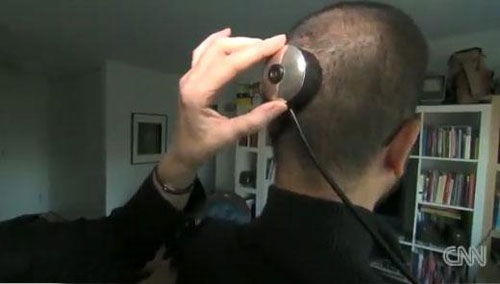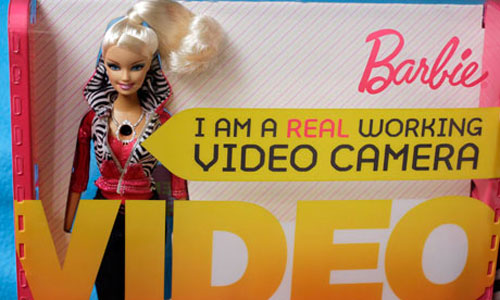Third I Blind
By:
December 15, 2010
Today artist Wafaa Bilal turns on the camera embedded in the back of his head. But Barbie has beaten him to it.

For Bilal, it’s an art project; he’s an assistant professor of photography at the Tisch School of the Arts at NYU. A thumbnail-sized camera has been attached via a “piercing-like attachment;” still images will be streamed at the rate of one per minute to Mathaf: Arab Museum of Modern Art, a newly-opened museum in Qatar. Bilal is Iraqi; his previous work includes a controversial hacked video game in which he inserted an avatar of himself as a suicide bomber trying to target then-President Bush; and a full-body tattoo of Iraqi cities with dots to mark Iraqi and American casualties from the Gulf War.

For Barbie, it’s just another marketing mashup: girls like dolls, girls like cameras, therefore…
It’s not just that we make cyborgs in our image; it’s that once they’re out there, we remake ourselves in theirs. Wishing to acquire some of their mechanical extensibility, we submit to conceptual limitations, and we are hard-pressed to say if there is a net gain. Despite the fact that of course our first steps in this direction are bound to be clunky and inelegant; these are steps we need to take, if at all, with all of our eyes open.
Of course we don’t have to go as far as embedded hardware. I have argued here before (Eloi and Morlocks, A Cyborg Manifested) that our use of computers encourages a reductive model of the self, in that we built and use the computer as a metaphor for the mind, and then extend that to the self, despite the fact that computers only mirror some aspects of the mind, and often in an oversimplified way that encases rather than expands. (Although when we do use it as a tool and not a mirror, it can extend our capabilities, and our selves.)
However, once we do get into hardware, the metaphor gets right in your face. Or the back of it. And then other directions (to which certain variables, once declared, can be assigned), come in for greater scrutiny.

In Barbie’s case, the immediate concern was not that she modeled some kind of late-stage emphysema victim, but that her camera could be used for pedophilia: girls like to dress Barbie but they also like to undress her, and they like to undress themselves, either en route to another outfit, or just en suite. Barbie could potentially film this. And Barbie’s films could potentially be hacked, or just hijacked by a local adult with bad intent.
For Bilal, the reaction is … not so different. Micro-documentation of a life has been done before, and with real-time video (lifecasting is a small yet persistent trend in the mediaspace, with deathcasting being its sad yet perhaps inevitable shadow side).

In Bilal’s case it’s not that we will see what he sees (we’re “behind” him, looking backwards, after all), but non-conceptual-art-world interests will want to know: is he getting any? And will we see that? I suppose that will depend on degrees of lighting, flexibility, and the strategic deployment of non-metaphorical mirrors. This may become an issue for some viewers in Qatar, where social, cultural and economic practices may not map seamlessly onto those of New York City’s East Village.
I should note that the camera faces out. Personally I’d be more interested if it faced in, and we could see what he was thinking all day. At least there’s Twitter.
“An artist is a mirror reflecting the social condition,” says Bilal. “Do we really have privacy these days? How many times each day is our image taken without our knowledge?”
By embedding a camera Bilal has turned from reflecting to recording. The artist is never just a mirror, he or she is an agent with agendas, whether or not they are fully acknowledged. Here’s one more guy, objectifying the inhabitants of the world with his gaze, this time literally, in the form of digital images. You don’t want to be tagged in his photostream? If you happen to pass him by, you won’t have much of a choice in that (except in the halls of NYU where he has promised to “leave the lens cap on”).

[Whales diving]
We’ve done this before with whales. We wanted to document not so much the whales themselves, as their great (and elusive) enemies, the giant squid. In 1997, scientists at Cornell collaborated with National Geographic Society researchers to embed “crittercams” in the whales’ blubber layer (using a tether that was engineered to dissolve, eventually) in order to see what the whale saw, as it dove. What it saw was the whales trying to get the camera off. The whales spent the entirety of the dive that we could see scraping against each other and bashing at the camera; they succeeded in getting rid of it, and the recording stopped there. (Giant squid have since been photographed, using other methods.)

[Facebook friends]
There’s no such thing as documenting only your world; there’s no extraction from our social matrices. When we document a life, to some degree we’re all implicated. Our communications technologies illuminate and identify these always-already connections with a much higher resolution. If his streamed photos reveal a different perspective on Bilal’s social networks, or limn a lyricism in his everyday errands, it may be a case in which limitation can facilitate a sharpened focus. As the project proceeds, we will, of course, see.
Of course we can always subvert the male gaze with laughter. Barbie’s earlier augmentations were hacked in the 1990s by the Barbie Liberation Organization, which famously switched voiceboxes on Barbies (which had prerecorded entries like, “Math is hard!”) with voiceboxes on G.I Joes (“Dead men tell no tales!”), and then placed them back on shelves, leaving the new owners to consider how deeply gender politics can be embedded in our toys, and the interactions they model back to us.
If Bilal can add sufficient absurdum to his reductio, he may yet succeed in observing something new.
